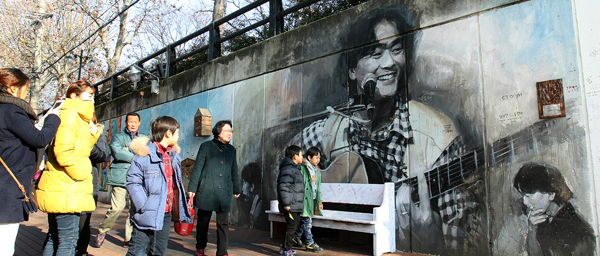Turning K-pop into tourism

After an episode of “Hidden Singer 2” aired on TV about Korea’s legendary folk singer Kim Kwang-seok, a Daegu road dedicated to the singer became a hot tourist spot.
Fifteen years ago, the American music magazine Billboard first used the term “K-pop.” While Korea gets an average of 10 million foreign visitors every year, there have been few efforts to utilize K-pop as a tourism resource. It is about time we create a grand strategy for developing the intangible cultural asset of pop culture into tangible tourist attractions, such as a pop music museum.
What can we learn from rock ’n’ roll landmarks in other countries? First, the selection of a site for a pop music museum is the key. The government is currently planning to build such a museum in Goyang City, just northwest of Seoul in Gyeonggi. Major pop music landmarks around the world are associated with the historical background of the location. The Rock and Roll Hall of Fame and Museum is located in Cleveland, Ohio, where the term “rock ’n’ roll” was first coined. Beatles fans visit Liverpool, England, where the legendary band was formed.
In addition, curators need to be trained. The government cannot completely manage a pop music museum by itself. Local governments, residents and artists need to cooperate, and curators should be the focal point. The curators of a pop music museum should program relevant exhibitions and collect related items. The suit that Psy wore when he first performed “Gentleman,” the backdrop that Cho Yong-pil used at the news conference for the release of “Hello,” the dress that Patti Kim wore at her retirement concert and the stage design from the 2013 Mnet Asian Music Awards could be Korean pop music treasures some day. Furthermore, the curators could discover and develop uniquely Korean music contests, such as a College Music Contest. While pop music curator is an unfamiliar profession in Korea, professionals specializing in Korean popular music must be developed.
Storytelling is another key. Sun Studio in Memphis, Tennessee, where Elvis Presley recorded his first album, tracked down and acquired the DJ booth where Elvis’s first song was played 60 years ago. They understand the power of moving stories. Storytelling is important to understand what should be presented and how. Let’s not just make an old-fashioned museum of exhibits with placards beside them. Interactive exhibitions and hands-on programs are already common at pop music landmarks abroad.
Data accumulation is also important. Pop music tourism became tremendously successful in America because pop music journalism has been established since the founding of Rolling Stone magazine in 1967. The British Music Experience, a pop music museum, took two years to prepare its information. Aside from K-pop idols’ photo books, however, periodicals specializing in popular music are almost nonexistent here.
The museum also needs to prepare thoroughly for foreign visitors. Chinese and Japanese tourists make up 60 percent of all visitors to Korea, 36 percent and 23 percent, respectively, and they are the biggest source of K-pop fans. So a music museum should provide guides in at least four languages: Korean, Chinese, Japanese and English. The Popular Music Exhibition in Seoul Olympic Hall is the main exhibition available at the moment in Korea for pop music, but it has little accurate information that foreigners can use and there are numerous spelling errors.
Popular music-themed tourism resources have long been common in other countries. K-pop is a major element of the Korean Wave, and it has grown into an attractive tourism resource, not just a cultural product. There is no reason to delay the development of Korean popular music tourism resources.
Translation by the Korea JoongAng Daily staff.
*The author is a professor and the head of Future Vision Board at Kookmin University.
By Cho Hyun-jin










with the Korea JoongAng Daily
To write comments, please log in to one of the accounts.
Standards Board Policy (0/250자)